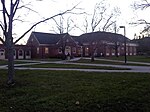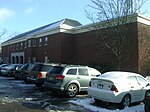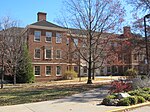Goggin Ice Center

Goggin Ice Center (The Goggin) is a multi-purpose sports facility in Oxford, Ohio on the Miami University campus. It replaced the Goggin Ice Arena. Like its predecessor, it is named for Lloyd Goggin, former school vice president who was instrumental in building the original ice arena. The Goggin features two ice rinks. The "A Pad," used for main events, is known as Steve Cady Arena, and is home to the RedHawks hockey team and synchronized skating team. The "B Pad" is used for recreational skating. The building also hosts intramural hockey and broomball programs, Jr. RedHawks youth and Talawanda High School varsity hockey clubs, hockey camps, skating lessons, ice shows and other events.
Excerpt from the Wikipedia article Goggin Ice Center (License: CC BY-SA 3.0, Authors, Images).Goggin Ice Center
Oak Street, Oxford Township
Geographical coordinates (GPS) Address Phone number Website Nearby Places Show on map
Geographical coordinates (GPS)
| Latitude | Longitude |
|---|---|
| N 39.50361 ° | E -84.73696 ° |
Address
Goggin Ice Arena
Oak Street
45056 Oxford Township
Ohio, United States
Open on Google Maps









